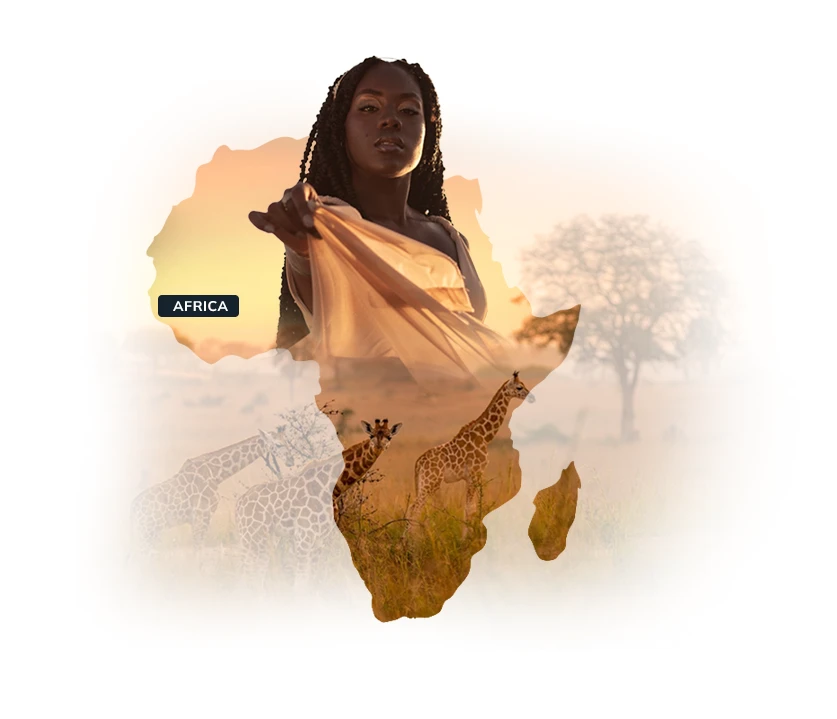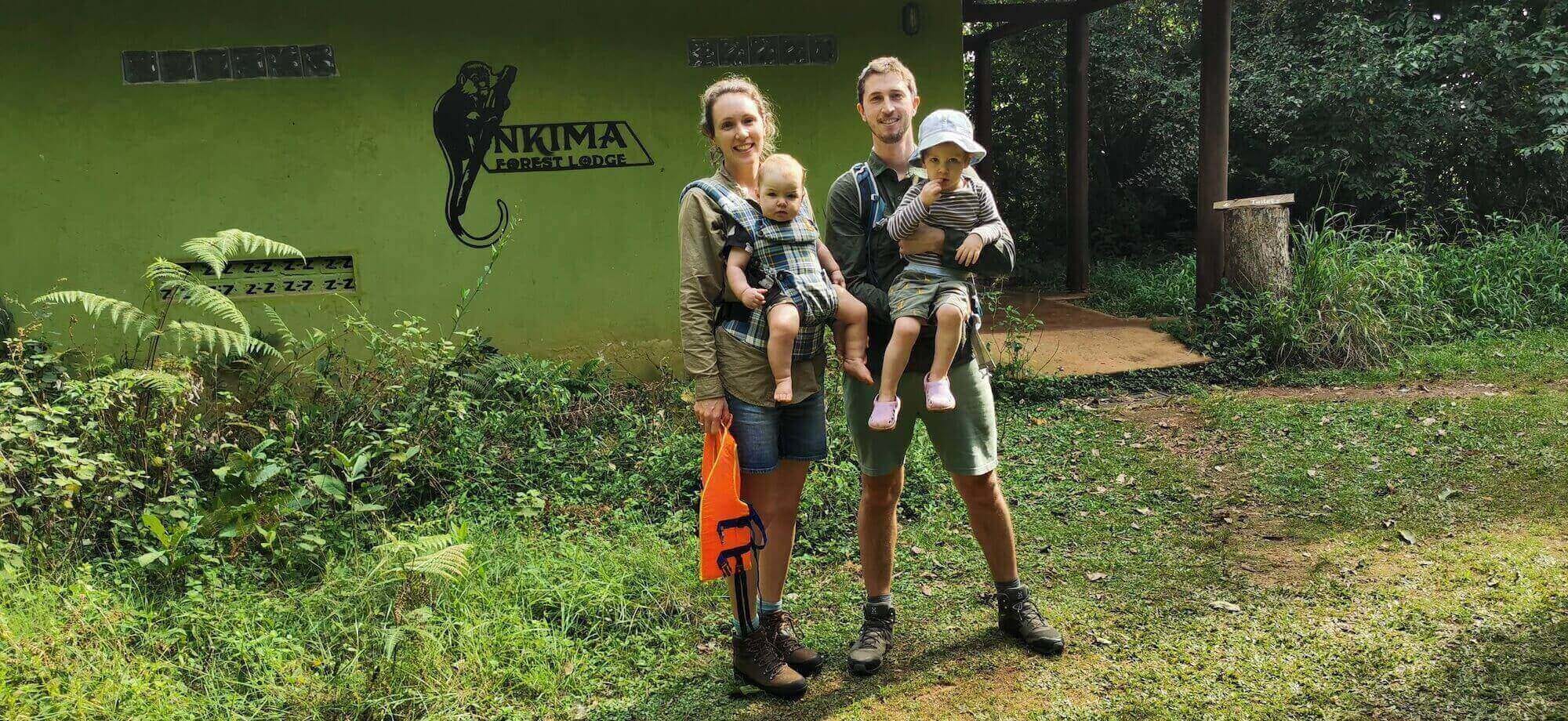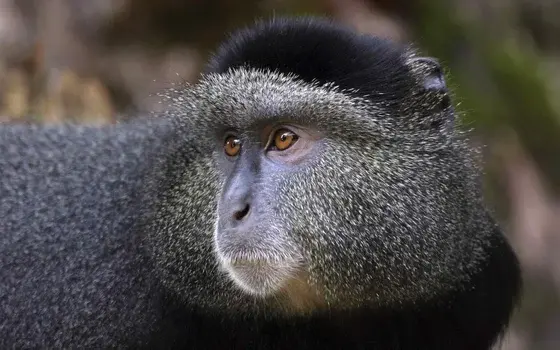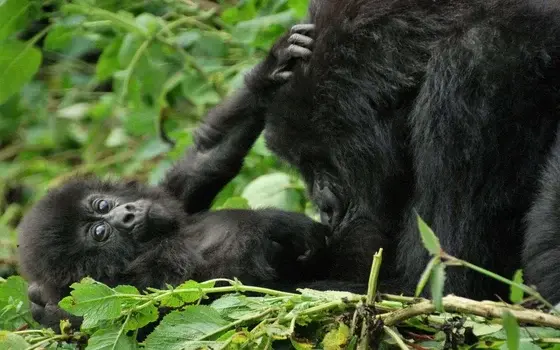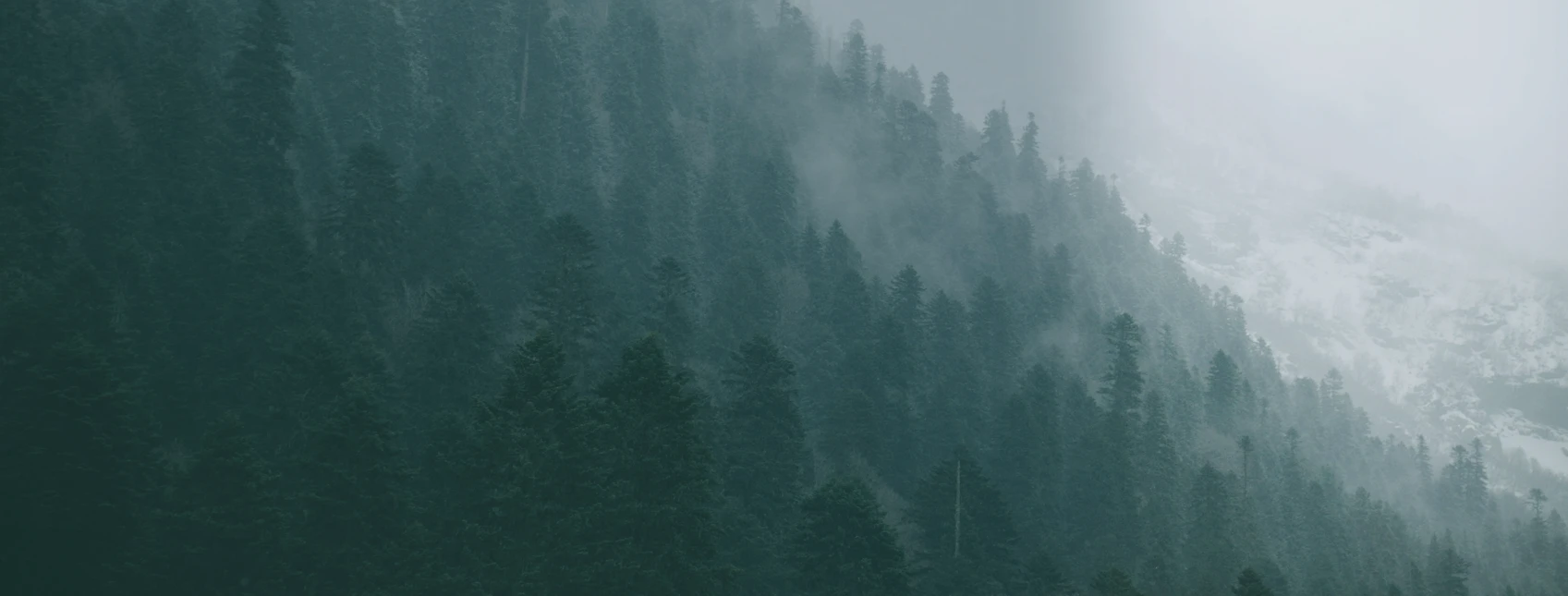Only about 1,000 mountain gorillas survive in the wild, living in Rwanda, Uganda, and the Democratic Republic of Congo. Decades of protection have turned Rwanda into a conservation success story, with rangers and police safeguarding gorilla families and a share of permit revenue supporting parks and local communities. A trek isn’t easy! Expect mud, altitude, and steep trails, but an hour in their world is unforgettable: playful youngsters, watchful silverbacks, and quiet moments you’ll carry home.
Read on to discover everything you need about gorilla trekking in Rwanda.
- • Where to Find Mountain Gorillas in Rwanda
- • How to Get to Volcanoes National Park
- • What to Expect on a Gorilla Trek in Rwanda
- • Photography of the Gorillas
- • Gorilla Permits in Rwanda
- • Where to Stay in Volcanoes National Park
- • What to Pack for a Gorilla Trekking Safari in Rwanda
Where to Find Mountain Gorillas in Rwanda
Just over half of the global mountain gorilla population lives in the Virunga Mountains, a chain of volcanoes spanning Rwanda, Uganda, and the DRC. The best place to see them is Parc National des Volcans (Volcanoes National Park) in Rwanda.
How to Get to Volcanoes National Park
Fly into Rwanda’s capital city of Kigali for a 30-day single-entry tourist visa upon arrival (typically $50). Always confirm current rules with Rwanda Immigration before you travel. The park sits about 65 miles (105 km) from Kigali, roughly a two-hour drive.
Wayfairer Top Tip
You can easily combine Rwanda with a Big Five safari holiday in Kenya or Tanzania, or a beach holiday in Zanzibar. Our Gorillas, Masai Mara & Zanzibar vacation itinerary can be fully customized to suit your needs.

Parc National des Volcans (Volcanoes National Park)
Conservationist Dian Fossey spent 20 years studying mountain gorillas in Volcanoes National Park. Thanks to her work, poaching was curtailed in time to save these majestic animals. The park is featured in the film Gorillas in the Mist (1988), which chronicles Dian’s work.
There are about 12 habituated mountain gorilla families in Volcanoes National Park. To protect the animals, groups are limited to eight trekkers, and time with the gorillas is capped at one hour.
Best Time to Visit Rwanda
You can trek year-round. Dry months (roughly June to September) bring firmer trails. Rains peak around March to May and October to November, which means muddier paths, but the air often clears after showers and can be great for photography.

What to Expect on a Gorilla Trek in Rwanda
Arrive at Kinigi Park headquarters by 7:00 a.m. for a safety briefing and group assignment. Treks usually begin around 8:30 a.m. and can take 2–9 hours round-trip, depending on where your assigned family ranges and your group’s pace. Trails can be steep, muddy, and humid, and the altitude adds effort. A reasonable fitness level helps make your experience more enjoyable
Meeting the Mountain Gorillas of Rwanda
When you find the family, you’ll have up to one hour to observe them quietly.
Gorilla etiquette:
- • Speak softly and avoid sudden movement.
- • Keep a respectful distance of about 16 feet.
- • Follow the ranger's instructions at all times; these are wild animals.
- • Flash is not allowed.
Tip: Consider two treks on separate days. No two encounters feel the same; many travelers spend the first hour on photos and the second simply soaking it in.
Why We Love It
“Once you find a gorilla family, the ranger advises you to keep a reasonable distance; however, the gorillas do not always follow this rule! One of the females suddenly came out of the bush and sat no more than five metres from me. I was told to sit still, and she too sat still. She studied me, and I studied her. There was no fear, just intense curiosity. The hour seemed to rush by! When the hour is up, the group has a certain feeling of calm. There was no excited chatter, and it almost seemed respectful to stay quiet until a reasonable distance away. It truly was a once-in-a-lifetime experience.”

Photography of the Gorillas
Taking photographs of gorillas is challenging due to the light conditions and the unpredictable distance between you and the gorillas. Your time with them is limited; therefore, you should ensure you’re as prepared as possible to get the best photos.
Low light and a moving subject are the main challenges. Disable flash and plan a few key shots rather than rapid-fire frames. A DSLR or mirrorless body that handles high ISO helps; a 70–200mm lens is useful at the 7-meter viewing distance. Phones can capture excellent moments, too, so focus on steady hands and composition.
Your time with the gorillas is precious, so plan your shots rather than shooting away wildly. You should balance absorbing this incredible experience and photographing these fascinating creatures.

Wayfairer Top Tip
Ensure your camera’s battery is fully charged and your memory card has plenty of space. You should also make sure that your camera has a waterproof bag or cover, as it can rain year-round in the rainforest.
Gorilla Permits in Rwanda
Visiting mountain gorillas is strictly managed to protect the species. Rwanda issues a maximum of 96 trekking permits daily for Volcanoes National Park, allocated across habituated families (8 people per group, 1 hour with the gorillas). It’s highly recommended that you book well in advance. Wayfairer will make arrangements for your trekking permits from the Rwanda Development Board. Current guidance lists the price at $1,500 USD per person, but prices are subject to change.
Rwanda Gorilla Trekking Notes
- • The minimum age to trek is 15
• If you are sick on the day of your trek, rangers may not allow you to join to protect the gorillas from human illnesses. Ask about current refund policies when you book.
Where to Stay in Volcanoes National Park

We recommend staying close to Volcanoes National Park. You'll be close to the park headquarters (you must arrive at 7:00 a.m. for your pre-trek briefing), and you'll have the chance to soak up the spectacular natural beauty of the Virunga region.
Luxurious Lodges Near Volcanoes National Park
Early morning starts and long, muddy trails make a comfortable base priceless. Virunga Lodge and Sabyinyo Silverback Lodge sit close to Volcanoes National Park’s headquarters, and pair big views with warm Rwandan hospitality. Fireplaces, hot showers, and hearty meals are just a few of the thoughtful touches that feel amazing after your trek. You also have the opportunity to support local conservation and community projects by staying in these authentic Rwandan lodges.
Virunga Lodge
As one of the most sought-after lodges in Africa, Virunga Lodge is the leading gorilla lodge in Rwanda.
Set high on a ridge, with panoramic views over the Musanze Valley, Lake Bulera, Ruhondo, and the Virunga Volcanoes, your luxurious banda cottage will allow you to soak up the breathtaking sights from the comfort of your home.
There are only ten bandas, each featuring a private terrace to watch the sunrise, a cozy fireplace, a luxury shower room, and colorful Rwandese fabrics and furniture.
You’ll also have a butler to assist you with your stay, from cleaning muddy boots to booking complimentary massages.
Located only a 40-minute drive from Volcanoes National Park, the lodge is a magnificent base from which to see Rwanda's mountain gorillas.
Besides meeting the famous residents of the region, there’s plenty to do around the lodge. You can explore the property on the maze of trails and terraced gardens winding down the mountain slope, including treks to the Karisimbi or Visoke Volcanoes and Dian Fossey's grave.
There’s also the brilliant Dian Fossey Map Room, filled with fascinating sketches, old maps, and books about the famous residents of Volcanoes National Park.

Sabyinyo Silverback Lodge
Hidden deep in the foothills of the mighty Virungas, Sabyinyo Silverback Lodge is an exceptionally luxurious lodge in a prime location. Set less than 2 miles from the main entrance to Volcanoes National Park, you’ll be well-placed for your trek to see the mountain gorillas.
It’s also the perfect place to return to after trekking in the dense forest. Only nine stylish cottages, made from local stone and terracotta, are available, and you’ll adore the property's tranquility.
There’s an on-site spa to soothe aching muscles, and you’ll melt into your beautiful cottage, which has a gorgeous fireplace and large private decks with stunning views of the volcanoes and forest. Sip freshly brewed coffee on your deck in the morning, watch the glorious sunset each evening, or take out your binoculars to spot some of the 600 bird species flying around the forest.
As Rwanda’s first community-owned lodge, Sabyinyo is committed to driving socio-economic and conservation initiatives around the National Park. There are also plenty of opportunities to visit local community projects.

What to Pack for a Gorilla Trekking Safari in Rwanda
It’s essential to come prepared, but you don’t need heaps of gear. Domestic flights often limit luggage to about 44 lb (20 kg) per person. A soft duffel helps you maximize space.
- • Sturdy, waterproof hiking boots with ankle support (well broken-in).
- • Light, breathable, waterproof jackets and pants; long-sleeve shirts.
• Warm layers for chilly mornings and cool nights.- • Long, lightweight woolen socks.
• Wide-brimmed hat and sunglasses.
• Toiletries: sunscreen, insect repellent, after-sun, bite relief cream, lip balm.- • Garden gloves to protect your hands as you grip vegetation.
- • Small daypack for water, lunch, layers, binoculars, and camera.
- • Camera with extra batteries and memory; binoculars.
- • Snacks for a long trek (2–9 hours).
• Reusable water bottle.
• Multi-way travel adapter. Rwanda uses plug types C and J and operates on 220V/50Hz.
Look at Rwanda's Pack for a Purpose page. It recommends donating supplies and dropping them off at partnering hotels, lodges, and schools. Check out our Responsible Travel Guide: Rwanda for more information about local customs and etiquette.
Get in touch with our travel specialists to start planning your Rwanda gorilla trekking safari!
